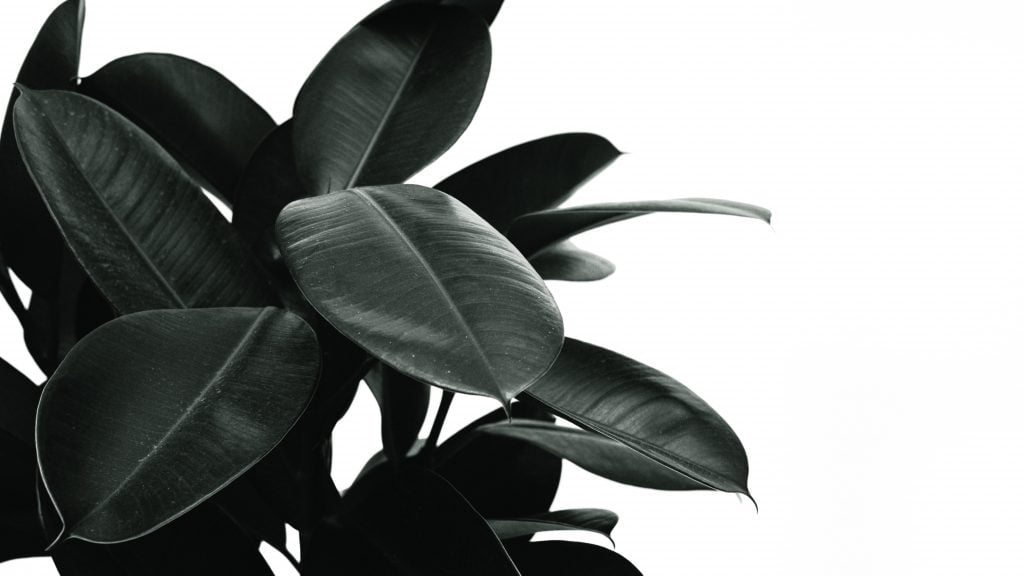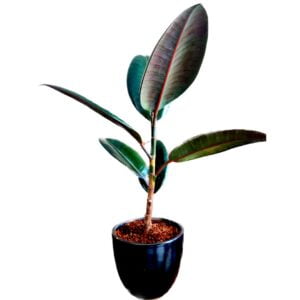In the past couple of years, the ubiquitous fiddle leaf fig, also known as rubber plant, has been a prevalent plant species and has overshadowed almost all the competition, especially when it comes to famous in-house tree-like plants. However, now we believe that we should all give this plant the limelight it deserves. With its deep, large, and green leaves, this plant does make a perfect pick to be a part of your home décor for the years to follow.

Formally known as ficus elastica, rubber tree can be grown either as a mid-sized house plant or grown big to be the center of attraction of your house. Of course, the only thing that the rubber plant requires from you is a lot of patience. Rubber Plants will adapt better to indoor living than the mature plant. If you are cautious, a rubber plant can grow to impressive heights in just a few years, especially if you place the plant outside during the summer months. On the other hand, if you place your rubber plant in a small pot, it will curtail its growth. So, if you want to keep them smaller, small pots can be your pick.
Buy Rubber Plant Bonsai Tree
You can choose to get a younger plant or an aged rubber plant bonsai tree. The choice is always yours. If you intend to keep it as home decor piece in the living room, you should go with the well developed bonsai tree.
- Original price was: ₹1,300.00.₹899.00Current price is: ₹899.00.
Watch this beautiful video about the Rubber Plant
How to take care of Rubber Plant?
When it comes to caring for your rubber plant, you need to give it the right balance of light and water. The good thing is you can control the amount of water and the light that your plant gets. This is necessary as too much of either of the two will be bad for your plant. In addition to light and water, you also need to be careful about other parameters of care. Let us address them one by one.
Do rubber plants need direct sunlight?
A house rubber plant does prefer light. However, it prefers indirect light, which is neither very hot nor very bright. Typically, people like keeping the rubber plant near a window. A window with sheer curtains is a great place. This ensures that the plant gets adequate light, but not so much.
Watering and fertilizing the rubber plant
The water needs of a rubber plant are season dependent. In the growing season, that is, during the summer months, the plant must be kept very well moist. So, during the summer months, you can wipe your leaves with a damp cloth or mist your plants. On the other hand, you will have to water the plant in the dormant season only once or maybe twice a month. Keep a check on your plant for the droopy leaves. If the leaves appear droopy, it implies that your plant needs more water.
My Rubber Plant Leaves are turning brown & yellow?
On the other hand, when the leaves turn brown and yellow, it could indicate over-watering the plant. If the outside air is too dry, you can mist the plant. This is a good practice in the winter indoors when the heated dry air makes the air around very dry. A useful tip for watering the rubber plant is using lukewarm water. Alternatively, you can take some cold tap water and let it stand until room temperature. This allows the chlorine evaporation and simultaneously lowers the shock, which the cold water can bring to your plant roots.
You should fertilize the plant strictly during the growing season, as is usual with most indoor plants.
Right Type of Soil for Rubber Plant
Your rubber plant does not appreciate sitting in the water. Thus, having well-draining soil is pivotal. Your plant needs well-aerated and well-draining potting soil. For this, you can take 1 part pine bark, 1 part peat, and I part perlite or coarse sand. Together this will make a phenomenal mix.
Appropriate Temperature for Rubber Plant
For a rubber plant to thrive, it needs a temperature between 60 degrees Fahrenheit to 75 degrees Fahrenheit. During the winter months, the plant can thrive even in low temperatures, that is, 50 degrees Fahrenheit.
Like the water and light requirements, you need to ensure a good temperature balance for your plant to grow well. The rubber plant likes humid and moist air owing to its tropical origin. However, this plant can survive even in the less humid temperature too. Your rubber plant reacts to temperature changes and prefers living in areas with balanced temperature and humidity.
Is Rubber Plant good for home?
Rubber Plant sap may lead to skin irritation and redness in a few people. Thus, it is recommended that you wash your hands thoroughly after coming in contact with the plant, especially its sap. As far as the consumption of this ficus plant goes, it may lead to mild stomach trouble. In some people, it can even cause vomiting or diarrhea, depending on the quantity of consumption.
Controlling Pests on the Rubber Plant
Some mealy bugs, scales, mites, and aphids are the prevalent bugs, making a home in the plant. If detected early, you can remove these bugs by wiping them with warm water and soap solution. Alternatively, you can even use an insecticidal soap.
Problems of Rubber Plant
Because of the persistent need for balance, it is easier to make your rubber plant unhappy, mostly if you overlook its needs. To combat this, you should pay strict attention to the degree of light your plant is receiving, the room temperature, the soil’s moisture level, and the other vital parameters mentioned above. These plants are particularly vulnerable to plant diseases related to overwatering. Thus, be careful and water again only once the soil in the plant has completely dried out. It is vital to prevent the drowning of the plant.
How to Repot the Rubber Plant?
To enable the plant to grow to its full length, you need to report it. It is best advised to do it every year or every few years. The timeline depends mainly on the pot’s size and the growth rate of the plant. If you wish to keep your plant to its current size, we do not recommend repotting it.
Propagation of Rubber Plant
To propagate your plant, you need to take a tiny branch from any healthy rubber plant. Then, root it in water or soil. Firstly, you need to let the sap from the plant’s stem dry before you plant it. Another great way of propagating the plant is via air layering.
For doing so, you need to make a cut in the healthy plant and stick in a toothpick at the plant’s opening. You can then wrap it in damp moss and wrap the plastic wrap around the moss to keep it on the toothpick. After the roots begin to grow on the moss, you can pluck the branch and root it in fresh soil.
Pruning of Rubber Plant Bonsai
To help the plant support itself, you need to prune it. Pruning is vital to facilitate growth and control the plant’s size to ensure that it does not overgrow. The ideal time to prune the plant is in the spring months. Further, it would help if you avoided pruning during the winter months. But, experts suggest that a rubber plant can be pruned at any time of the year. If you cut the rubber plant branches, it can release a part of the plant’s sap.
Overall, caring for your rubber plant is easy. You need to keep an eye on the plant to honor the balance. If you desire a tall and a full-grown plant, good care is quintessential.
Is Rubber Plant Good For Home?
Rubber plant is good for home as it is one of the most tolerant, easy to grow, and gorgeous looking air purifying plant. The dark green leaves make it look exotic in your home garden.


